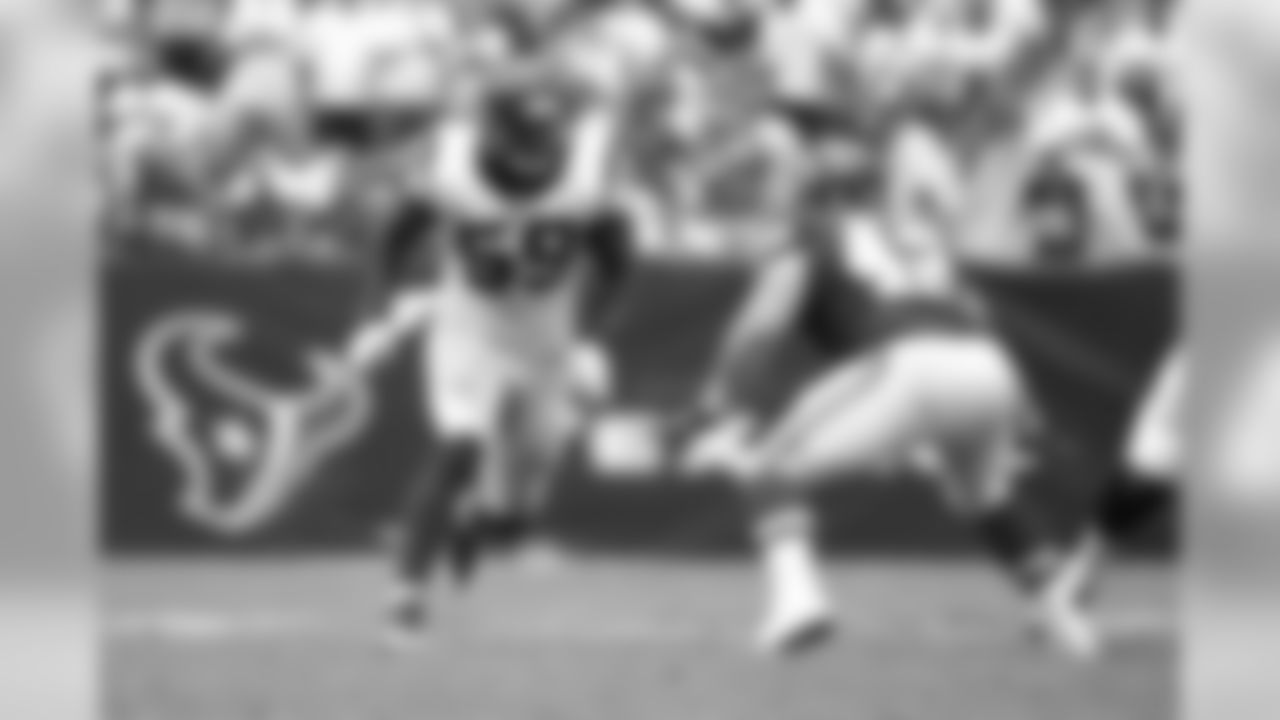Photos of Texans' projected starters as listed on team's depth chart.


























Statistics can help illuminate the game of football…or they can take us down a misleading path. As Tampa Bay Buccaneers Head Coach Lovie Smith said: "I believe in stats, but it's [which] stats."
Smith, for instance, doesn't pay much attention to the NFL's defensive rankings, since they are based on yards, which he considers a meaningless measure. When he shares defensive stats with his team, he focuses on points allowed, takeaways, scoring on defense and red zone proficiency.
Here on Buccaneers.com, we unabashedly love stats, but we also understand the need to wield them wisely. Sometimes, we can get a better feel for why the team is performing as it is by going a little deeper into the numbers. Other times, we simply want to point out a few numbers we consider interesting, and hope you will find it interesting as well.
That's our goal with Football Geekery. Each week, we're going to give you a sampling of statistical and/or historical analysis, hopefully in a way that is relevant to the Buccaneers' current state of affairs. This week we note the Bucs' struggles on third downs on both sides of the ball and wonder which area is more important to get settled. We also look at team outcomes when individual players hit certain marks such as 100 yards rushing, then finish up by checking in on a Football Outsiders chart regarding pass defense on throws to different parts of the field. Let's get started.
**
1. Third and Critical
The Buccaneers are 1-1 after two weeks, and considering the vast differences in their performance from Week One to Week Two, the statistics surrounding the team are, unsurprisingly, a mixed bag. In the league rankings, Tampa Bay owns a top-10 spot in some categories (yards allowed per game, sacks per pass play, kickoff return average) and a bottom-10 spot in some others (first downs per game, points allowed per game, interception rate).
The Bucs showed significant improvement in New Orleans last Sunday after a tough opener. If they want to continue on an upward trajectory, one area in which they will likely need to improve on both sides of the ball is third-down efficiency. The offense's conversion rate of 28.6% ranks 28th in the league while the defense's allowed rate of 47.8% ranks 25th.
As the game has become more offensive-minded through the years, the overall third-down rate around the league has nudged upward. When the Buccaneers first began play in 1976, the league-wide third-down rate was 37.5%. Last year, it was 39.9%. Therefore, the Bucs' current defensive third-down rate, while clearly not where it needs to be, isn't as much of an anomaly as it might have been two decades ago. After all, there are seven teams worse.
However, if that rate stayed where it was for the rest of the season, it would be the worst single-season third-down rate allowed in franchise history. Meanwhile, the offense's mark would be the third-worst in Buc annals.
So, which one is more important for the Buccaneers to get right? Based just on Tampa Bay's own history, it's the defensive rate that most needs to improve.
If you rank the Bucs' first 39 seasons on third down conversion rate allowed, from lowest to highest, six of the top eight seasons are playoff campaigns, and seven of the top 11. Noneof the bottom 14 seasons on the list ended in the postseason. Here are the top 10 seasons from that list:

If you rank those seasons by the offense's third-down rate, from highest to lowest, the playoff seasons are much more spread out. None of the top seven seasons on that list ended in playoff berths, but three of the bottom 13 did. Here are the top 10 seasons from that list:

Overall, the 10 teams that had the best defensive third down success in Buc history combined for a winning percentage of .556, while the top 10 on the offensive side combined for a winning percentage of .469.2. Super Superlatives
In Week One, second-year tight end Austin Seferian-Jenkins caught five passes for 110 yards and two touchdowns. It was the first 100-yard game of his career and the 153rd such performance by any Buccaneer in the team's 40-season history.
In NFL parlance, 100-yard receiving games, 100-yard rushing games and 300-yard passing games are often referred to as "superlative" performances. So far, Seferian-Jenkins is the only Buccaneer with a superlative this season, and unfortunately his came in a loss.
Historically, as far as the Bucs are concerned, superlative performances are not necessarily linked to victories, particularly in the two passing categories. Individuals with 100-yard rushing games are much more likely to pair that with victory, and the reason isn't difficult to discern. It's that old matter of cause-and-effect again; teams that are winning are more likely to stick with the running game, giving the back more of a chance to pump up his stats. Teams that are behind are more likely to throw, so quarterbacks and receivers can sometimes put up bigger numbers in unsuccessful comeback attempts.
Pictures from the Bucs' practice on Wednesday, September 23rd at One Buccaneer Place in Tampa.













































Still, some players in Buccaneer history have seen their superlative performances more often linked to victory. Some of that can be attributed to the relative strengths of the teams for which those players toiled. For instance, Michael Pittman's seven 100-yard rushing games came during a six-year stretch that included three playoff seasons. Reggie Cobb had seven 100-yard games as a Buccaneer, as well, but never once played on a winning team. On the other hand, we should give players like Pittman credit for being part of the reason their teams were successful.
So, which players in Buccaneer history were most likely to lead their teams to victory when they cracked the 100 or 300-yard marks? Let's consider only players who had at least five superlative performances in their given categories, and then rank them by winning percentage.
100-Yard Rushing Games

(* Alstott was on the team in 2007 but spent the entire season on injured reserve. The team's win-loss record in that season was not included in these totals.)*
We've also included the Buccaneers' *overall win-loss percentage for the blocks of seasons that each player was on the team. The final column is the difference between that overall winning percentage and what it was when the player had his superlative performances. A positive number in that final column means the team's winning percentage improved by that much during this superlative games.*
*
The teams for both Mike Alstott and Earnest Graham were undefeated when they got to 100 yards on a given Sunday, but Alstott's tenure was marked with more winning overall. Thus, Graham's 100-yard games did more to improve the fortunes of his team than any other back on the list. The only player whose teams were actually worse off when he got to 100 yards was LeGarrette Blount, and only by the very slimmest of margins.*
Again, this is not to suggest that any player achieving 100 or 300 yards is *hurting his team by doing so. This is just a look at how such outings have correlated with wins and losses, regardless of cause and effect. Of course, there are legions of Mike Alstott fans who don't need any more convincing that it was a good thing when he was piling up the yardage.*
*100-Yard Receiving Games

For the reasons discussed above, it's not surprising that there are few positive numbers in the final column. Horace Copeland's 100-yard games most correlated with winning, but in the smallest sample size on the list. The Bucs were very good in 2002 and close to .500 in 2003, but it wasn't usually a successful night for the team when they had to (or simply happened to) get the ball to Keenan McCardell enough for a 100-yard game.300-Yard Passing Games

This list probably says more about the Buccaneers' style of play during its most successful periods. Both the playoff runs from 1979-82 and 1997-2002 were built mostly on outstanding defense and a strong running game. If the Bucs were throwing the ball enough to get their quarterback over 300 yards, they probably weren't in their intended game plan. Not one of the six quarterbacks on the list had a better winning percentage in his 300-yard games than his team did overall during his time with the Buccaneers, though Josh Freeman came the closest.3. Where to Pass
The excellent Football Outsiders website maintains a ranking of the 32 NFL defenses, updated each week, using a method called DVOA (Defense-adjusted Value Over Average), which they describe thusly: "DVOA measures a team's efficiency by comparing success on every single play to a league average based on situation and opponent." There is quite a bit that goes into the generation of their DVOA numbers, but for simple comparison's sake you just need to know that the lower the number is (and it goes into the negatives), the better it is for the defense.
What is particularly interesting on this page are the follow-up charts that break the teams' DVOA into specific situations. One chart we've referenced multiple times in previous Football Geekery articles separates a team's success in pass defense into how well it does against five different types of pass-catchers (#1 receivers, #2 receivers, other receivers, tight ends and running backs). Another looks at how well each team defends passes by direction, breaking it down into left, right or middle and deep or short.
It's that latter chart we want to highlight today, as it pertains to the Buccaneers' upcoming game against the Houston Texans. Does it provide us with any clues as to where Jameis Winston might find the most success targeting his throws on Sunday?
Well, according to the chart, the Buccaneers would be best served by throwing it over the middle, but not too deep. Overall, the Texans have had the sixth-best pass defense against deep throws, with a DVOA of -45.4%, and their DVOA on deep throws down the middle is a whopping -102.8%. That's the seventh-best mark in the NFL and it might suggest that veteran safeties Rahim Moore and Quintin Demps are playing well. Demps does have Houston's lone interception so far.
The Texans' DVOA on short passes is 8.9%, which ranks 25th in the league. Their worst DVOA against any kind of throw is short and in the middle, where their mark is 67.2%. Only seven teams have been worse in that situation. Overall, it looks like the Buccaneers would have better luck throwing to the left, where Houston ranks 21st with a 12.7% DVOA, than to the right, where they are 12th at -19.3%
























